Family : Sylviidae

Text © Dr. Gianfranco Colombo

English translation by Mario Beltramini
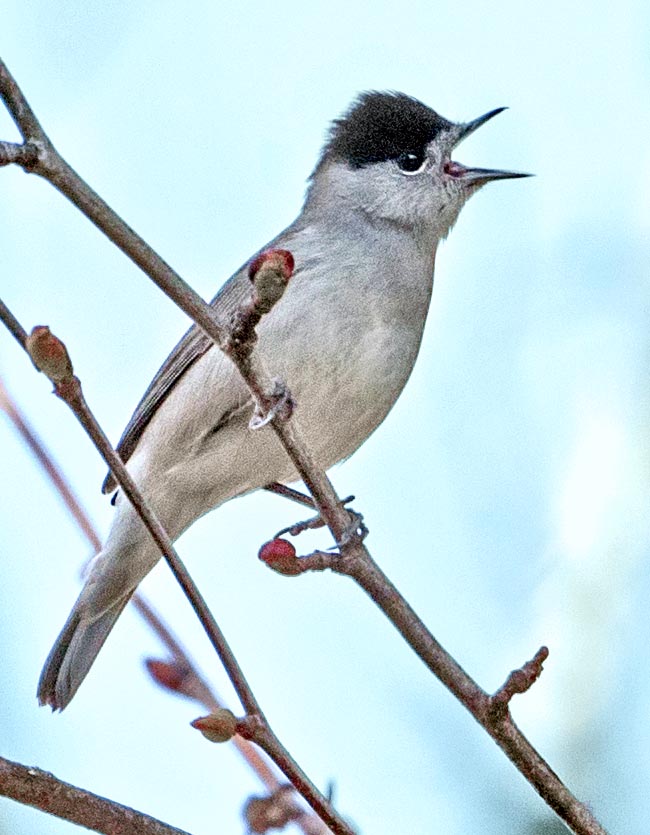
In spring-summer the male of Blackcap delimits a small territory with stentorian and fluty voice © G. Colombo
Among all little birds frequenting our gardens and our countries, the Blackcap is by far one of the most common and known.
There is no tradition not nominating it, no folklore not mentioning it, no story not citing it and no music not imitating it.
Over millennia, since when human knowledge had the upper hand on our primordial ignorance, this small bird together with others displaying characteristics more interesting than others, has been able to attract the curiosity of mankind.
Perhaps its popularity is due to its ubiquitous presence or to the coincidence of its chattering with the arrival of the good season, or also, due to its confidentiality, but without any doubt reason that struck more than any other, has been its stentorian and similar to a flute voice.
But also in this case we face a strong contradiction, as instead of giving an appropriate name for this pleasant song it has, they simply called it Blackcap, taking inspiration from this unique particular of its livery.
Actually, this small bird does not evidence morphological characteristics, such as to be remembered for its beauty or for the particular shape of its body, but simply because of the only small black mark appearing on its insignificant livery.
Moreover, maybe unknowingly, staining of male chauvinism, it has got a name of female gender, but referring to a male characteristic, when conversely, could be used the name of redcap, seen that the female has the hood of this colour.
On the other hand, in all Euro-Asian languages, with very few exceptions, the common name reflects the same characteristic indicated by the scientific name, with the black colour of the male getting the upper hand on the hazelnut one of the female.
The Blackcap (Sylvia atricapilla (Linnaeus, 1758)) belongs to the order of the Passeriformes and to the family of the Sylviidae even if in old times they often indicated it as a member of that of the Turdidae and of the Muscicapidae.
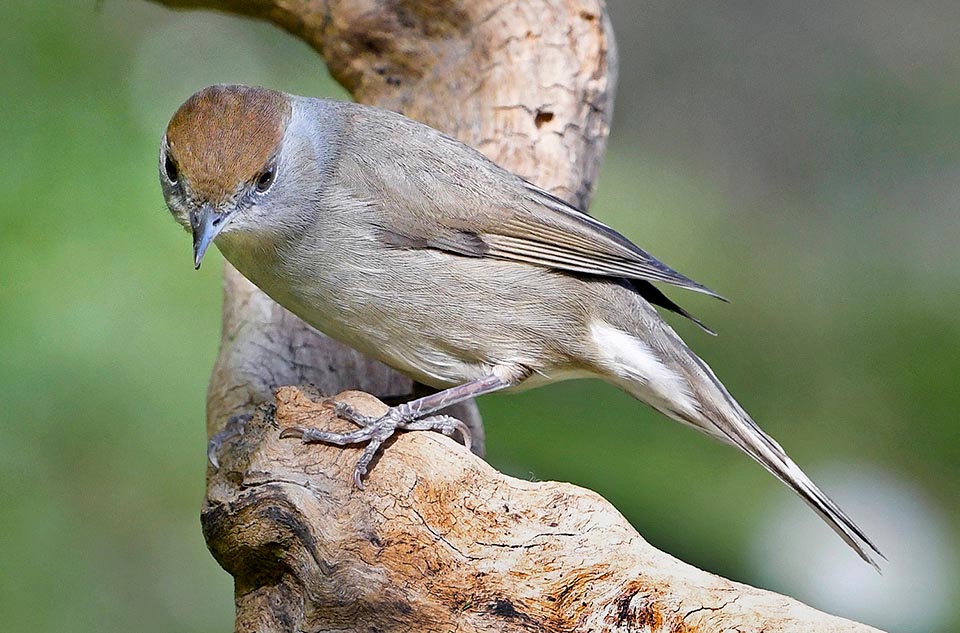
The females reach the nesting site little later, with their hazelnut cap, typically black in the males © Gianfranco Colombo
The scientific binomen gets its origin for both names, from Latin Sylvia from “sylvia”, small elf of the woods and atricapilla from “ater” = black and “capillum” = hair.
The international common names are, in English, Blackcap, in German Mönchsgrasmücke, in Spanish, Curruca Capirotada, in French, Fauvette à tête noire, in Portuguese, Toutinegra de barrette preto, in Italian, Capinera, and in Japanese a nice Zuguromushikui.
Zoogeography
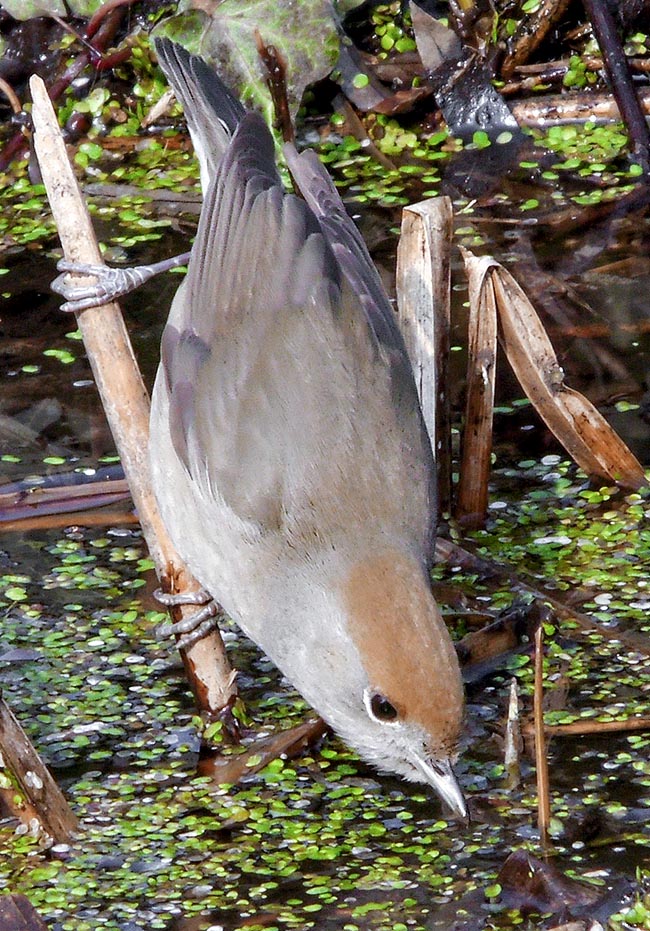
A curious female near a body of water © Pierandrea Brichetti
The Blackcap has a wide and varied distribution area including almost all Europe, but the north-western regions, Asia up to south-western Siberia, southward, from Turkey up to Caucasus, in all Mediterranean Basin from the African coasts to Middle East and in the Atlantic islands of Macaronesia, and, following the western Atlantic coast, up to Cape Verde.
It is a resident or partially resident species in the southern sectors of its range, whilst is migratory for the populations living north.
The Mediterranean area and sub-Saharan Africa are interested in the migrations of these populations that gather there during the bad season to avoid the seasonal rigors of the high latitudes. The Central Asian populations reach the countries of East Africa up to Tanzania.
Also for the Blackcap as happens for other migratory species like the White stork, there is an imaginary line crossing continental Europe that separates the western migratory wave that will interest the Iberian Peninsula, from the eastern one bound to the Bosphorus.
A longitudinal line that crosses the European continent roughly from Denmark to the Lake of Garda.
Often, in Europe, we observe a more insistent stay during the winter, taking advantage of the climate changes that, during the last few decades are interesting our temperate climates.
Some populations of Central Europe and of the Scandinavian Peninsula, strong of the capacity of this species to diversify totally the diet from insectivorous to frugivorous, choose more and more often as winter quarters the British Isles, living practically in the gardens and in the city parks, where they find berries and sufficient food to overcome the period. The Blackcaps subject to migrations, leave the nesting quarters already in the month of August and beginning of September but are equally prompt to start the return voyage already by the end of March.
The world population is very important and is estimated in around 150 million of individuals (BirdLifeInternational).
Ecology-Habitat
Like all Sylviids, also the Blackcap has an innate predisposition to accept the most varied habitats.
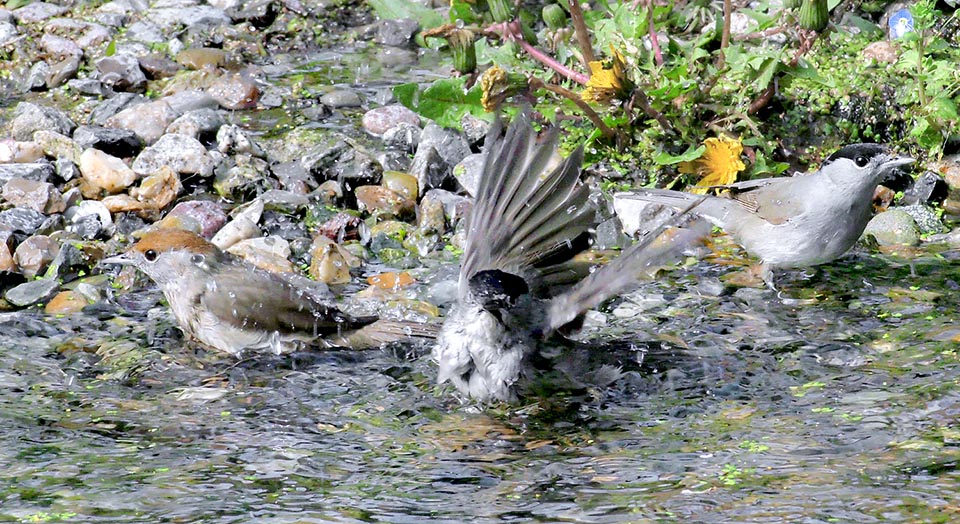
It has seen, not far, two males bathing and gets close. Maybe one of them will show her the nests done for the marriage © Pierandrea Brichetti
It is atavistically a bird of the underwood and of the shrubby areas, of brambles and of dense small trees with ramifications reaching the ground but do not disdain banks of ditches in densely cultivated areas, rods of troughs and tangles of elderberries leaning on old rural constructions.
Nevertheless, it is often found in city gardens even if small, but furnished with small plants or shrubs that allow it to hide during the day and to find the place where to place the nest.
In autumn and in winter it is attracted by all sorts of berries and fruits, from the elderberries to the pokeweeds, from figs to kaki, without ignoring some crumbs of cake or samples of apple, visiting the mangers located in the gardens for feeding other birdies.
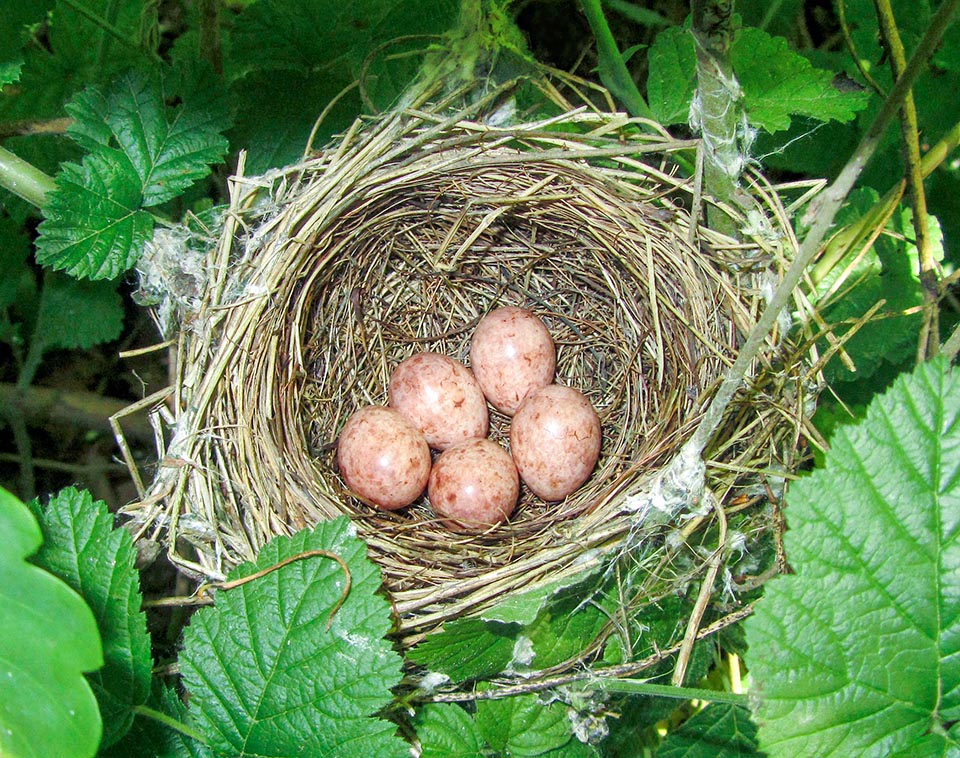
Apparently irregular and ill-shaped platforms, but well woven with dry grass blades tied to the twigs on which it is placed. Unstable and shaky, but at the same time safe and flexible with at the center a soft cup well defined. Here are laid 4/5 cream, often suffused of pink, eggs dotted of reddish spots © Museo Civico di Lentate sul Seveso
Morphophysiology
The Blackcap does not have a particularly varied and coloured livery, conversely, this is rather modest and uniform if it were not for the black hood of the male and the hazelnut colour of the female. The livery of both genders is greyish on the back and on the remiges, with the lower part of the body paler and tending to light ash-grey.
The young, in their immature livery, have the head always of amber colour even if from a very careful examination, that can be done only with the specimen in the hand, can be noted under the hazelnut colour of the hood sign of the future black feathers.
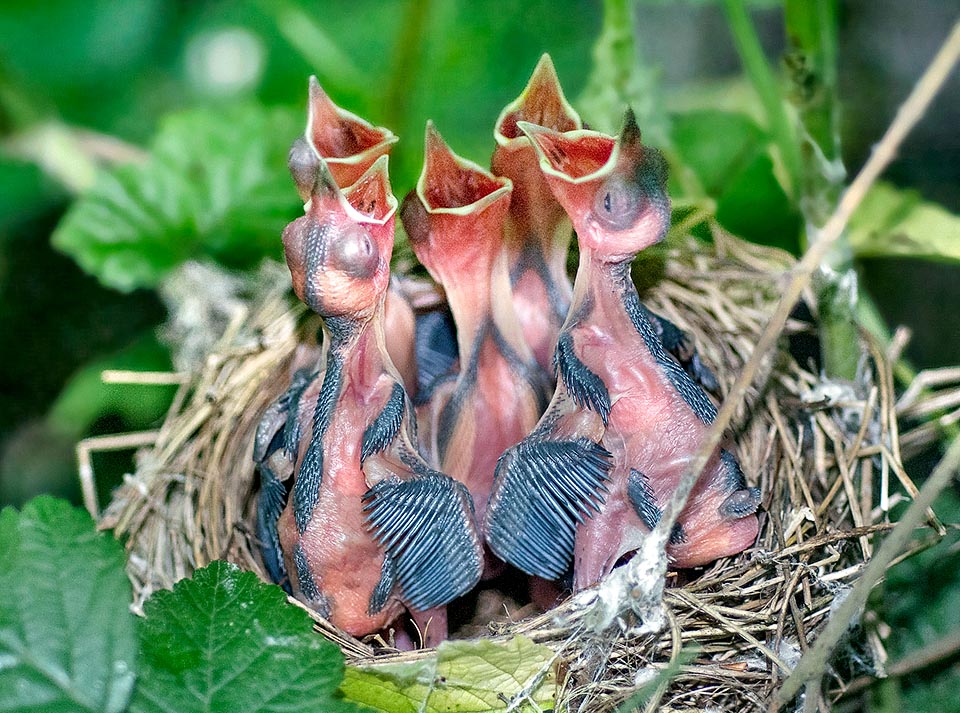
Hatch is done mainly by the female for about 15 days, whilst the young imploring for food is fed by both parents © Museo Civico di Lentate sul Seveso
The Blackcap is a sylviid with strong constitution even if the long tail, the slender legs and the unstoppable frenzy of movement give it an appearance of natural lightness and slenderness.
This capacity it has is well clear when it goes jumping in the thickest brambles avoiding with absolute dexterity spines and tangles of small branches that render the bush almost impenetrable.
The bill is greyish, robust but at the same time fine and pointed, typical to the insectivorous birds but able to transform in winter, in a handy tool capable of detaching and gulp down the big berries of pokeweed.
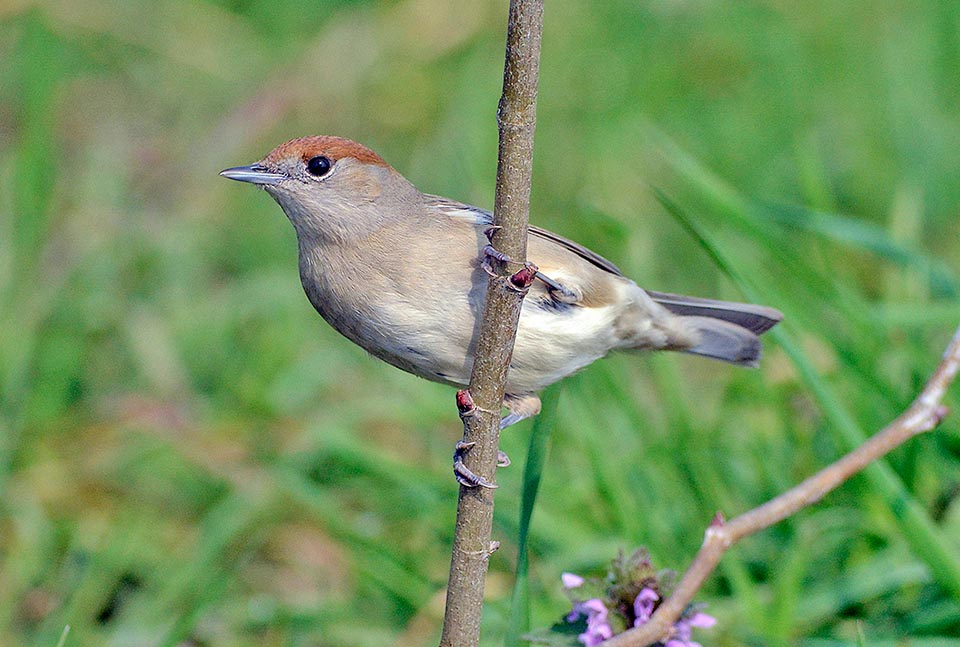
For 10 days, up to take off, female and male go looking for insects to feed them, then survey them for short time more © Alvaro Dellera
Though standing among the biggest sylviids, the Blackcap has a rather reduced size, being only 15 cm long, a weight of 20 g and a wingspan of about 25 cm.
Having a rather vast territory, also for this bird have been identified some subspecies of some well-defined areas and with slightly different hues from the holotype, even if difficult to notice on the field. Sylvia atricapilla atricapilla, typical to continental Europe and the northern Asian belt, Sylvia atricapilla dammholzi, of the Asian southern belt, Sylvia atricapilla gularis of Açores and Cape Verde, Sylvia atricapilla heineken Canary Islands, Madeira and west African coasts, Sylvia atricapilla pauluccii, of the Mediterranean area.
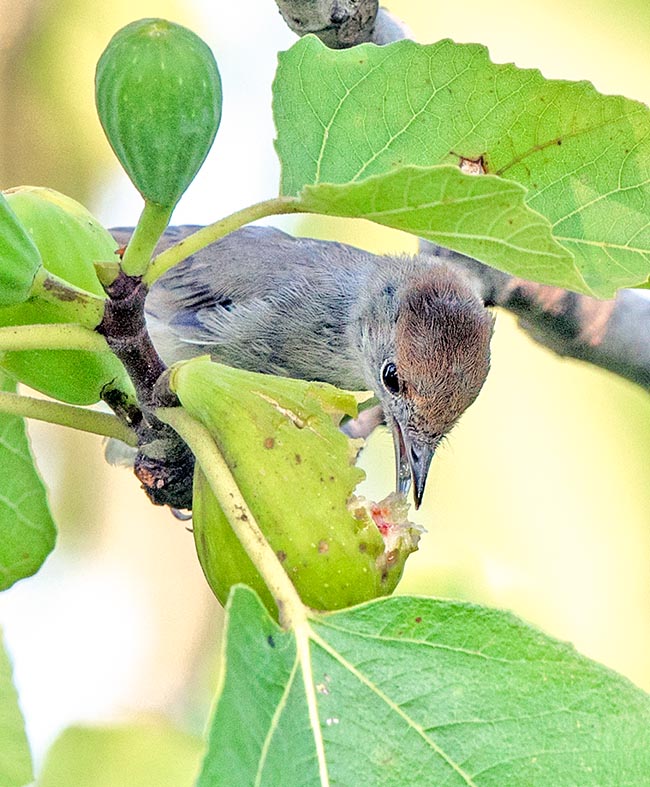
This young of Sylvia atricapilla have learnt quickly to eat figs. Initially is difficult to say if it’s a male or female, unless not raising by hand the feathers of the head to see if the black ones are coming out © Gianfranco Colombo
Ethology and Reproductive Biology
The Blackcap male anticipates the arrival and the settling of the female in the nesting site of a few days, just in time to conquer an area available and suitable to its demands, after having signalled loudly its presence and having sent away the numerous contenders.
The conquered territory is however very reduced and at times it is placed a few metres away from that of its competitor who, like its neighbour, goes on with undaunted shouts to the four winds the possession of its area.
During the spring and the summer seasons, all the groves resound of the continuous melodies of these birdies that tirelessly and along the whole day, signal and defend their own house with a series of trills, chatters, vocalizations, rattles and shrills that render it one of the most melodious birds of our woods.
A song with the same tonality as that of the famous Nightingale (Luscinia megarhynchos), very similar to that of the Garden warbler, (Sylvia borin), mistakable with that of the Common whitethroat (Sylvia communis) but unique in its frequency and perseverance.
Typical is the excited and subdued alarm tac-tac, emitted from the thick of low bushes, when a predator enters its territory.
The Blackcap is very reserved but is sociable and courageous, approaching up to a few metres anyone getting close but at the same time keeps always covered and renders itself almost invisible.
The nest is built in low bushes, in thick brambles or well-hidden on a climber at low height from the ground. The male, monogamous for the single season, since the first occupation of the territory, builds several nests waiting for the female to choose the one suitable for depositing the eggs, completing it with soft material and small rootlets.
An apparently irregular and ill-shaped though well woven platform with dry blades of grass tied to the twigs on which it is placed that render it unstable and shaly but at the same time safe and flexible.
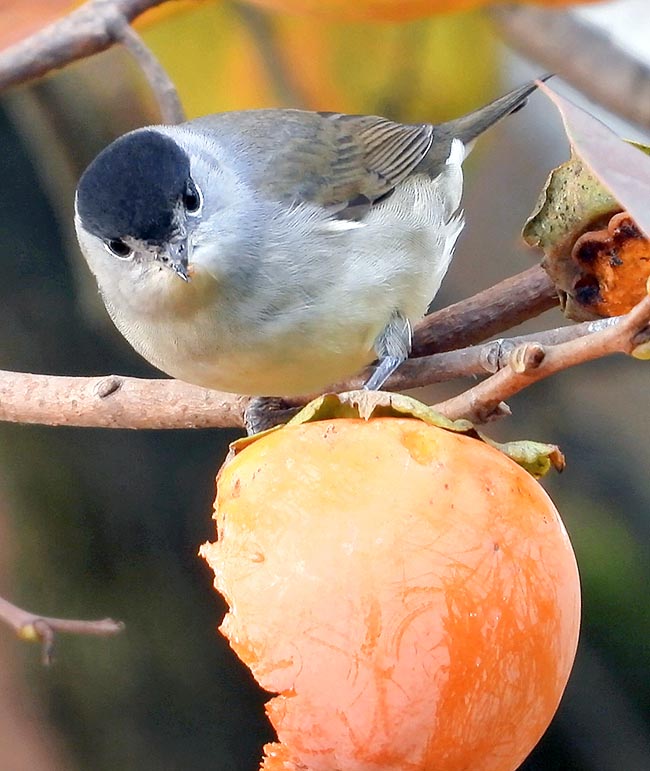
Greedy male found devouring a kaki. When by late August, doesn’t migrate in Africa, the Blackcap changes diet, from insectivorous to frugivorous, and often lives in vegetable and city gardens near the man © Pierandrea Brichetti
At the centre is formed a soft cup, well defined though not extremely deep.
4 to 5 eggs of cream colour will be laid there, often suffused with pink, much dotted on the whole shell, of reddish, sometimes greyish spots. Very similar to those of the Robin (Erithacus rubecula) and also of the Spotted flycatcher (Muscicapa striata).
Hatching is mainly performed by the female for about 15 days whilst the progeny is followed equally by both parents for 10 days until when the take-off occurs and for a further short period up to their final independence.
Maturity occurs after the first year.
Usually, are made two annual broods ending in mid-July, leaving to all the time necessary to get ready for the autumn migration.
As already mentioned, the Blackcap is insectivorous during the summer season and the nesting period whilst becomes strictly frugivorous in autumn and also in winter.
It its melodious song has been considered in classical literature as a sweet amorous lament done by a bird in cage who will die of starvation rather than losing freedom, so that Giovanni Verga in his “History of a Blackcap” revives it adapting it to the life of a nun forces to retire from private life.
Although it frequents reserved and hidden locations, the Blackcap has its predators.
The Sparrowhawk (Accipiter nisus) with its sneaky and sudden hunting, is its major predator but also the domestic cats make their damages in the gardens frequented by these small birds.
Also corvids often visit their nests, taking away the eggs and often the nestlings even more during the autumn migration, when during the long voyage to the African shores they are accompanied by an innumerable quantity of raptors.
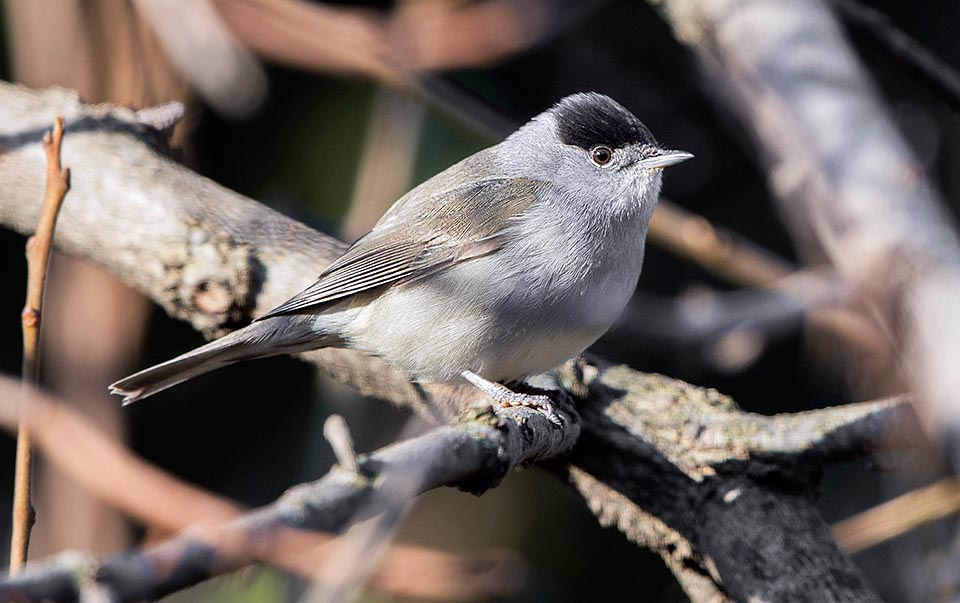
Chilled male in mid-winter. When temperatures raise, due to climate changes, the blackcaps of South Europe become more and more sedentary © Gianfranco Colombo
Last but not least, in the eastern coasts of Mediterranean, from Lebanon to Libya, this small bird is object in late autumn, of a pitiless hunting massacring millions of specimens every year in the name of a tradition difficult to eradicate.
Nevertheless, this species is not subject to dangers and holds a more than stable population.
Synonyms
Motacilla atricapilla Linnaeus, 1758.
→ To appreciate the biodiversity within PASSERIFORMES please click here.
